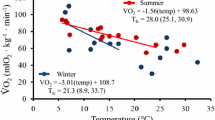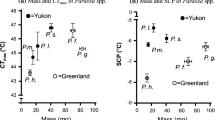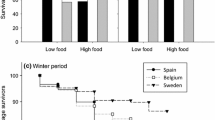Abstract
Decreases in snow cover due to climate change could alter the energetics and physiology of ectothermic animals that overwinter beneath snow, yet how snow cover interacts with physiological thresholds is unknown. We applied numerical simulation of overwintering metabolic rates coupled with field validation to determine the importance of snow cover and freezing to the overwintering lipid consumption of the freeze-tolerant Arctiid caterpillar Pyrrharctia isabella. Caterpillars that overwintered above the snow experienced mean temperatures 1.3°C lower than those below snow and consumed 18.36 mg less lipid of a total 68.97-mg reserve. Simulations showed that linear temperature effects on metabolic rate accounted for only 30% of the difference in lipid consumption. When metabolic suppression by freezing was included, 93% of the difference between animals that overwintered above and below snow was explained. Our results were robust to differences in temperature sensitivity of metabolic rate, changes in freezing point, and the magnitude of metabolic suppression by freezing. The majority of the energy savings was caused by the non-continuous reduction in metabolic rate due to freezing, the first example of the importance of temperature thresholds in the lipid use of overwintering insects.




Similar content being viewed by others
References
Alexander MA, Tomas R, Deser C, Lawrence DM (2010) The atmospheric response to projected terrestrial snow changes in the late twenty-first century. J Climate 23:6430–6437
Augspurger CK (2009) Spring 2007 warmth and frost: phenology, damage and refoliation in a temperate deciduous forest. Func Ecol 23:1031–1039
Bale JS, Hayward SA (2010) Insect overwintering in a changing climate. J Exp Biol 213:980–994
Bale JS, Worland MR, Block W (2001) Effects of summer frost exposures on the cold tolerance strategy of a sub-Antarctic beetle. J Insect Physiol 47:1161–1167
Benedetti-Cecchi L, Bertocci I, Vaselli S, Maggi E (2006) Temporal variance reverses the impact of high mean intensity of stress in climate change experiments. Ecology 87:2489–2499
Bennett VA, Kukal O, Lee RE (1999) Metabolic opportunists: feeding and temperature influence the rate and pattern of respiration in the High Arctic woollybear caterpillar Gynaephora groenlandica (Lymantriidae). J Exp Biol 202:47–53
Bokhorst S, Bjerke JW, Street LE, Callaghan TV, Phoenix GK (2011) Impacts of multiple extreme winter warming events on sub-Arctic heathland: phenology, reproduction, growth, and CO2 flux responses. Global Change Biol 17:2817–2830
Brown CL, Bale JS, Walters KF (2004) Freezing induces a loss of freeze tolerance in an overwintering insect. Proc R Soc London, Ser B 271:1507–1511
Chevin LM, Lande R, Mace GM (2010) Adaptation, plasticity, and extinction in a changing environment: towards a predictive theory. PLoS Biology 8:e1000357
Coulson SJ, Leinaas HP, Ims RA, Søvik G (2000) Experimental manipulation of the winter surface ice layer: the effects on a High Arctic soil microarthropod community. Ecography 23:299–306
Déry SJ, Brown RD (2007) Recent Northern Hemisphere snow cover extent trends and implications for the snow-albedo feedback. Geophys Res Lett 34:L22504
Deutsch CA, Tewksbury JJ, Huey RB, Sheldon KS, Ghalambor CK, Haak DC, Martin PR (2008) Impacts of climate warming on terrestrial ectotherms across latitude. Proc Natl Acad Sci USA 105:6668–6672
R Development Core Team (2010) R: a language and environment for statistical computing. R Foundation for Statistical Computing. http://www.R-project.org
Drake JM (2005) Population effects of increased climate variation. Proc R Soc London, Ser B 272:1823–1827
Easterling DR, Meehl GA, Parmesan C, Changnon SA, Karl TR, Mearns LO (2000) Climate extremes: observations, modeling, and impacts. Science 289:2068–2074
Gaines SD, Denny MW (1993) The largest, smallest, highest, lowest, longest and shortest: extremes in ecology. Ecology 74:1677–1692
Genc H (2005) Determination of sex in pupae of Phyciodes phaon (Lepidoptera: Nymphalidae). Fla Entomol 88:536–537
Goettel MS, Philogene BJR (1978) Laboratory rearing of the banded woollybear Pyrrharctia (Isia) isabella (Lepidoptera: Arctiidae), on different diets with notes on the biology of the species. Can Entomol 110:1077–1086
Hahn DA, Denlinger DL (2007) Meeting the energetic demands of insect diapause: nutrient storage and utilization. J Insect Physiol 53:760–773
Hochachka PW, Somero GN (2002) Temperature. In: Hochachka PW, Somero GN (eds) Biochemical adaptation: mechanism and process in physiological evolution. Oxford University Press, New York, pp 290–360
Irwin JT, Lee RE (2002) Energy and water conservation in frozen vs. supercooled larvae of the goldenrod gall fly, Eurosta solidaginis (Fitch) (Diptera: Tephritidae). J Exp Zool Part A 292:345–350
Irwin JT, Lee RE (2003) Cold winter microenvironments conserve energy and improve overwintering survival and potential fecundity of the goldenrod gall fly, Eurosta solidaginis. Oikos 100:71–78
Jentsch A, Kreyling J, Beierkuhnlein C (2007) A new generation of climate-change experiments: events, not trends. Front Ecol Environ 5:365–374
Layne JR, Blakely DL (2002) Effect of freeze temperature on ice formation and long-term survival of the woolly bear caterpillar (Pyrrharctia isabella). J Insect Physiol 48:1133–1137
Lee RE (2010) A primer on insect cold-tolerance. In: Denlinger DL, Lee RE (eds) Insect low temperature biology. Cambridge University Press, New York, pp 3–34
Marshall KE, Sinclair BJ (2011) The sub-lethal effects of repeated freezing in the woolly bear caterpillar Pyrrharctia isabella. J Exp Biol 214:1205–1212
Nickerson DM, Facey DE, Grossman GD (1989) Estimating physiological thresholds with continuous two-phase regression. Physiol Zool 62:866–887
Oberhauser KS (1997) Fecundity, lifespan and egg mass in butterflies: effects of male-derived nutrients and female size. Func Ecol 11:166–175
Schmidt-Nielsen K (1997) Energy metabolism. In: Schmidt-Nielsen K (ed) Animal physiology: adaptation and environment, 5th edn. Cambridge University Press, New York, pp 169–216
Sinclair BJ, Chown SL (2005) Deleterious effects of repeated cold exposure in a freeze-tolerant sub-Antarctic caterpillar. J Exp Biol 208:869–879
Sinclair BJ, Klok CJ, Chown SL (2004) Metabolism of the sub-Antarctic caterpillar Pringleophaga marioni during cooling, freezing and thawing. J Exp Biol 207:1287–1294
Sinclair BJ, Gibbs AG, Lee WK, Rajamohan A, Roberts SP, Socha JJ (2009) Synchrotron X-ray visualisation of ice formation in insects during lethal and non-lethal freezing. PLoS One 4:e8259
Stevens MM, Jackson S, Bester SA, Terblanche JS, Chown SL (2010) Oxygen limitation and thermal tolerance in two terrestrial arthropod species. J Exp Biol 213:2209–2218
Storey KB, Storey JM (1996) Natural freezing survival in animals. Annu Rev Ecol Syst 27:365–386
Van De Pol M, Ens BJ, Heg D, Brouwer L, Krol J, Maier M, Exo KM, Oosterbeer K, Lok T, Eising CM (2010) Do changes in the frequency, magnitude and timing of extreme climatic events threaten the population viability of coastal birds. J Appl Ecol 47:720–730
Voituron Y, Mouquet N, de Mazancourt C, Clobert J (2002) To freeze or not to freeze? An evolutionary perspective on the cold-hardiness strategies of overwintering ectotherms. Am Nat 160:255–270
Zhang T (2005) Influence of the seasonal snow cover on the ground thermal regime: an overview. Rev Geophys 43:RG4002
Zimmermann NE, Yoccoz NG, Edwards TC, Meier ES, Thuiller W, Guisan A, Schmatz DR, Pearman PB (2009) Climatic extremes improve predictions of spatial patterns of tree species. Proc Natl Acad Sci USA 106:19723–19728
Acknowledgments
We thank Moriah Sokolowski for technical assistance, Bonnie Tarnowski for assisting with caterpillar collection, Mhairi McFarlane for property access, Hiroko Udaka and Heath MacMillan for comments, and Hugh Henry, Yolanda Morbey, and several anonymous referees for constructive comments on earlier versions of the manuscript. This research was supported by the Canadian Foundation for Innovation, an Ontario Early Researcher Award and an NSERC Discovery grant to BJS.
Author information
Authors and Affiliations
Corresponding author
Additional information
Communicated by: Sven Thatje
An erratum to this article can be found at http://dx.doi.org/10.1007/s00114-011-0879-8
Rights and permissions
About this article
Cite this article
Marshall, K.E., Sinclair, B.J. Threshold temperatures mediate the impact of reduced snow cover on overwintering freeze-tolerant caterpillars. Naturwissenschaften 99, 33–41 (2012). https://doi.org/10.1007/s00114-011-0866-0
Received:
Revised:
Accepted:
Published:
Issue Date:
DOI: https://doi.org/10.1007/s00114-011-0866-0




